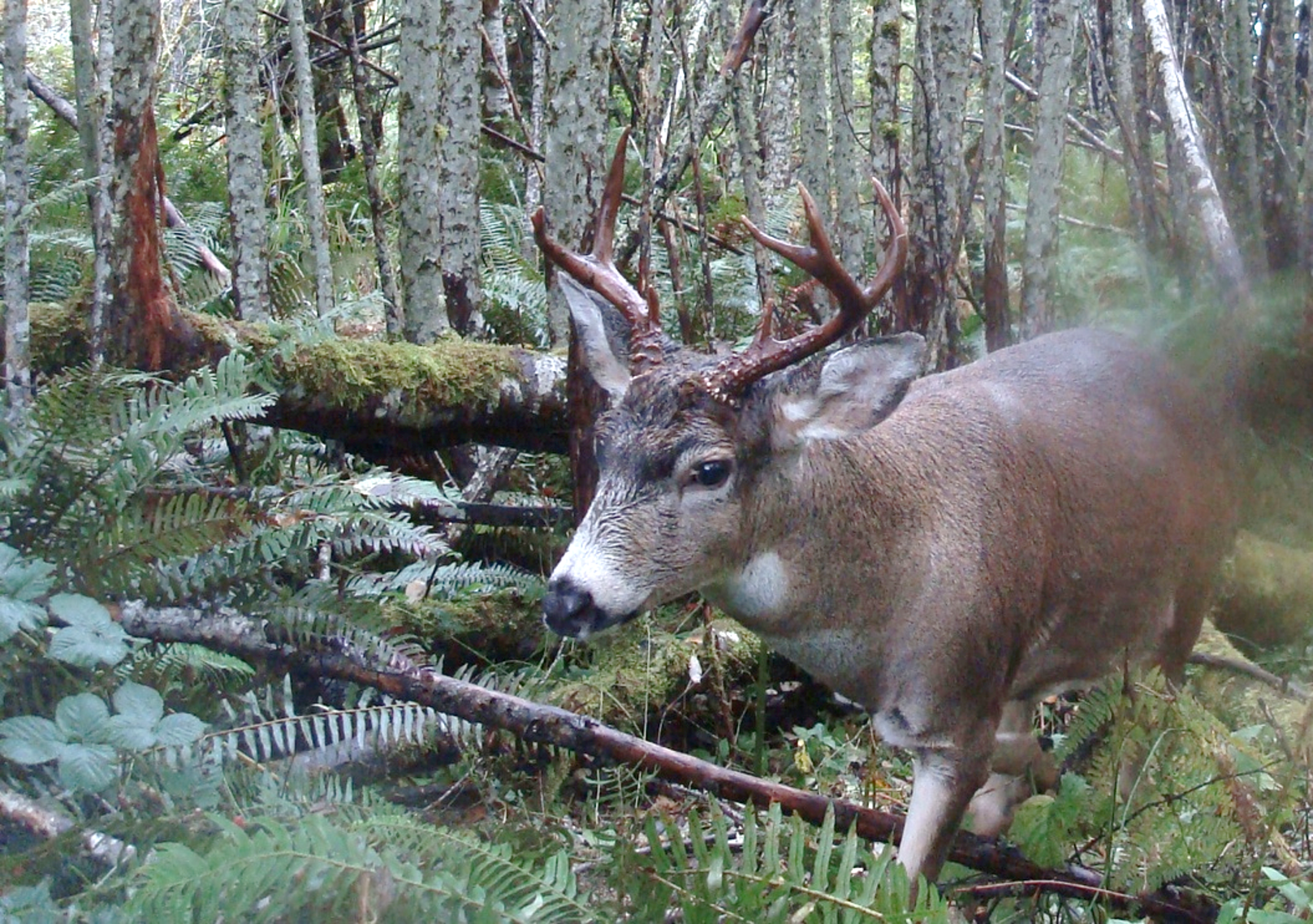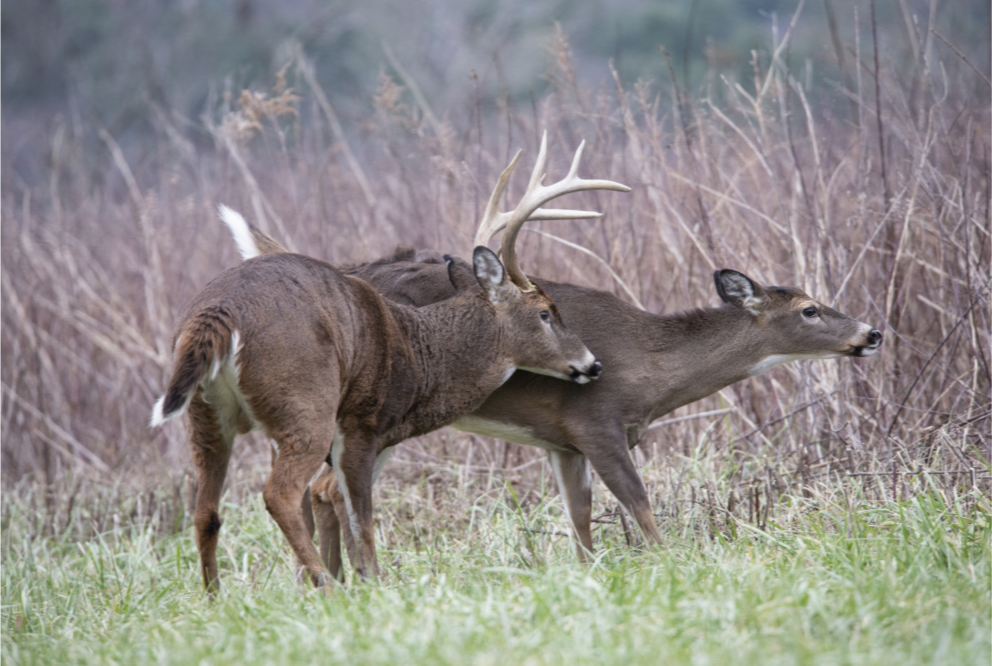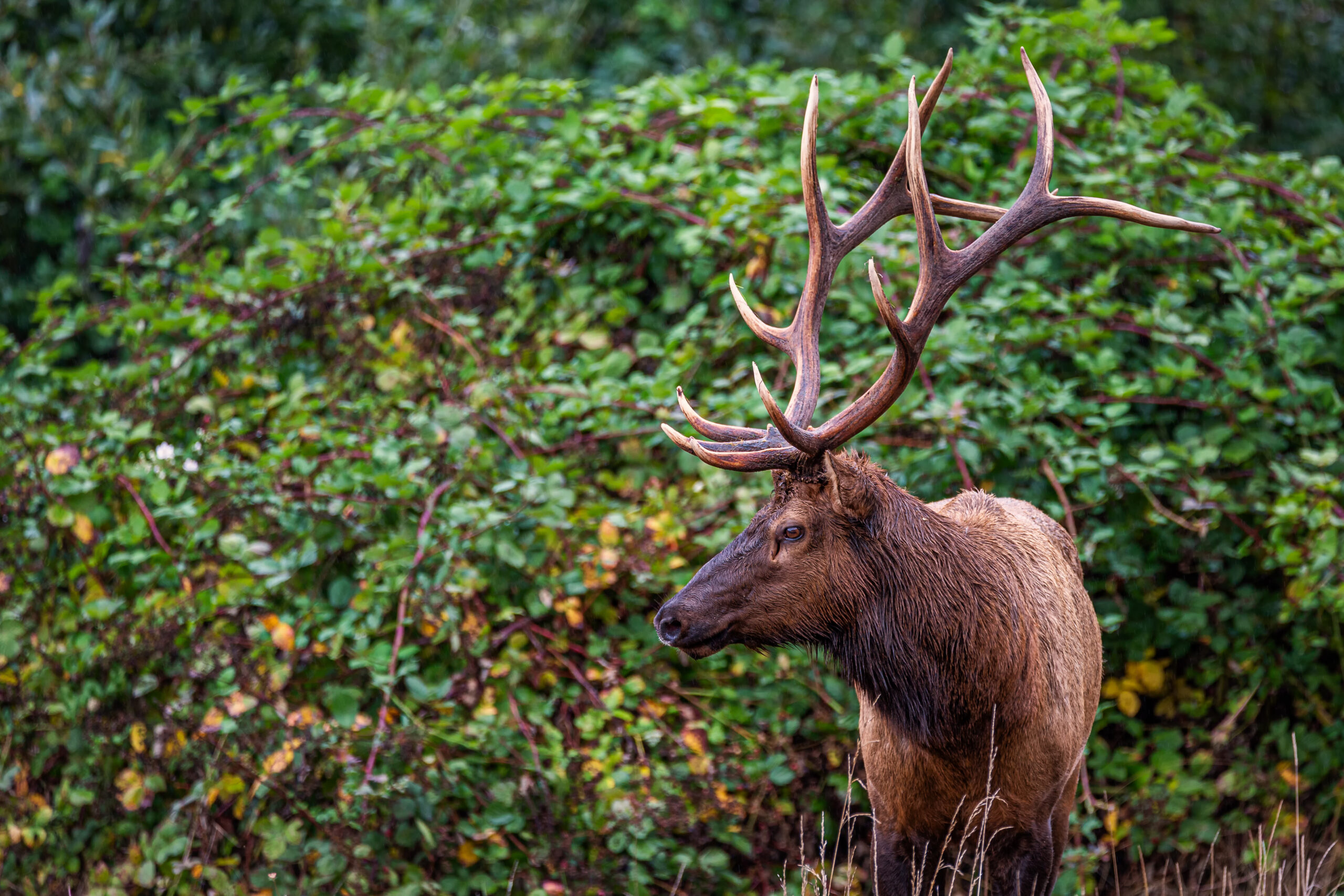
Monthly big game breakdown series: November 2021
Tips and tactics for deer and elk this month
By Tom Ryle/WDFW
We began this series last month, which I encourage you to review because it sets the stage and provides context as we now turn our focus to November. As a reminder, we also publish our Weekender report, which is chock-full of information to help you plan your next outing.
As I write this, our statewide general modern firearm deer season is underway. The anticipation and preparation for the annual tradition known as “deer camp” runs deep among many Washingtonians. The same can be said for elk camps across the state. Moms, dads, grandparents, cousins, and friends made by the light of the evening fire gather to celebrate this time-honored tradition. It’s a magical and memorable ritual cherished by many.
Hunter harvest success for deer hovers around 25 percent statewide across all user groups (see figure 1 below). Modern firearm hunters make up the bulk of deer hunters in Washington at nearly 20,000 participants annually. That means that roughly 25 of 100 deer hunters will fill their tag this fall. For elk, (see figure 2 below) harvest success sits at 10 percent.
I would be remiss not to mention that a “successful” hunting season isn’t solely measured by the harvesting of deer. Far from it. That said, the smiles, congratulatory hugs, and cheer expressed when a harvested deer shows up at camp is undeniably priceless for all who have the good fortune to share in that experience. Recounting the day’s hunt is part of the joy of making memories with family and friends. Read on for tips, tactics, and considerations that may help you fill the freezer with high quality game meat.

Figure 1 – 2020 deer harvest by weapon type (source: WDFW, see all harvest reports)

Figure 2 – 2020 elk harvest by weapon type (source: WDFW, see all harvest reports)
As I mentioned in the October edition of this series, fall is about change — the length of daylight decreases, nights get colder, testosterone levels surge in big game animals, and once again, the rainy season returns to the Pacific Northwest. It’s soggy on the westside, snowing in the mountains, and the onset of winter for Eastern Washington is fast-approaching. With all that in mind, let’s dive into some November tactics.
Before you go: Learn more about chronic wasting disease (CWD), epizootic hemorrhagic disease (EHD), and bluetongue.
With recent CWD cases appearing less than 200 miles away in Libby, Mont., WDFW is conducting a surveillance program during the 2021 deer hunting season. You can get all the information on the updated CWD webpage, including details on getting your harvested or roadkill-salvaged deer tested through much of this month.
Epizootic hemorrhagic disease (EHD) and bluetongue cases have spiked this year, which could result in whitetail numbers being down this year. The department has monitored these ailments for decades and the cases always increase during drought years.
One last thing: You can help with elk hoof disease
If you harvest an elk anywhere in Washington, please inspect all hooves and note if, in your opinion, they appear to be deformed or exhibit any abnormalities. You’ll be asked to report this information in your annual hunter report to help WDFW understand the distribution and prevalence of treponeme-associated hoof disease (TAHD) in elk in Washington.
For more information on TAHD and how to report your statewide observations, visit our elk hoof disease webpage or review pages 65-66 of the 2021 Big Game Hunting Seasons and Regulations pamphlet. WDFW also has a pilot incentive program with an exclusive draw opportunity to measure how Western Washington hunters specifically can help with elk hoof disease.
November
Whitetails, blacktails, and mule deer will all be focused on breeding this month. When you hear people talking about the rut, they are referring to the annual breeding ritual. It’s important to know that the rut comprises several distinct phases (below). Understanding these phases is important to your hunting strategy and tactics. Keep in mind that these are general guidelines to help you understand the dynamics as they relate to your hunt.
Pre-rut (late October into early November)
- Decreasing daylight triggers increased testosterone levels in bucks.
- Bucks begin to pursue does and frequent doe-group hangouts.
- Most does are not in estrous yet and often are harassed by young bucks.
- Scent-checking does, bedding areas, and trail systems becomes an all-day activity for bucks.
- Older, experienced bucks will hang back until does come into estrous.
Peak rut, a.k.a. peak breeding (mid-November)
- The majority of does are bred during the peak rut.
- Bucks will not leave an estrous doe until he can breed her.
- Bucks will fight if pecking-order issues arise, though most of the time posturing will sort out differences before a battle ensues. Rattling antlers to emulate bucks sparring or fighting can pull deer into your location.
- Bucks will not eat normally as they are preoccupied with breeding. They will often travel far and wide in search of receptive does.
Post rut (late November into early December)
- With most breeding complete, bucks may turn focus to recovering from the peak rut.
- Does will continue about their business of fattening up for winter.
Secondary rut (mid-December)
- Not all does get bred during the primary rut in November. Any does that were not bred then will come back into estrous 22-29 days from their first cycle, around mid-December. Naturally, this condition can cause a lot of competition in the deer woods. Bucks will once again seek out receptive does and this activity can last through December in my experience.
Mule deer
As mentioned, mule deer live in a variety of habitats. November typically brings snow to the high country, which can help concentrate deer at the snow line elevation. Older bucks will endure the early storms and not migrate as quickly as younger bucks and most doe groups. Glassing for deer remains an excellent tactic to locate deer early and late in the day and focus more on south-facing slopes that receive the warmth of the sun. The trajectory of the sun melts snows quicker, exposing prime food sources. Secondly, when deer bed for the day, they will take advantage of the sun’s warmth.
In general, mule deer in the northern latitudes will begin the pre-rut during the very end of October, ramping into November. This means they will be focused on hanging around doe groups in their core range. Focus on these doe groups early and late in the day, and you might intercept a buck scent-checking their estrous status.

Mule deer bucks sparring in snow.
As the second half of the month rolls near, you’ll want to increase your focus on locating does. Where you find does, you will find a buck — or two, or more! Peak breeding occurs in mid- to late November, so bucks will be consumed with seeking out receptive mates. Again, focus on prime feed areas early and late in the day, but don’t discount the mid-day hours. Bucks will be up and moving all day scent-checking every doe they can find. Many tags are notched between 10 a.m. and 3 p.m. by those willing to endure inclement weather or cold temperatures.
One of the most exciting ways to pursue mule deer is by cutting a fresh track in the snow and following it out. If you attempt this, keep in mind that deer will nearly always walk in a direct path until they are looking for a place to bed. If your track begins to wander, slow down and monitor the wind constantly. Bucks will bed to take advantage of the thermals, their ears, and eyes. They will often keep the wind at their back and watch their backtrail. Use binoculars to glass ahead. If they spot you coming, they’ll leave before you even knew they were there.
Black-tailed deer
Black-tailed deer are highly nocturnal once they shed the velvet from their antlers, typically around the last week of August. This nocturnal tendency is well-known and the bane of blacktail hunters.
The good news is that these highly secretive bucks experience a boost of testosterone in late October that lasts through most of November. The urge to procreate predisposes them to leave their secret haunts in pursuit of does, often during daylight hours. A common theme for November is focus on does, doe groups, doe bedding locations and the trails between bedding and feeding. Bucks will frequent these locations and often hang on the downwind side to stay efficient in their scent-checking duties.
Still-hunting big timber stands during cold, rainy days is a go-to tactic for many successful blacktail hunters, regardless of weapon. Many of my archery bucks were taken on the ground while still-hunting during the pre-rut. Another go-to tactic is to use a treestand within range of a known trail intersection. I prefer intersections because the convergence of several trails increases my odds of deer encounters.

Black-tailed buck cruising. (Tom Ryle/WDFW)
Rattling antlers and/or using a deer call to make soft doe bleats accounts for the majority of my blacktail shot opportunities. As mentioned above, target bedding areas, feed areas, and trails connecting these locations. Bucks will almost always circle downwind of your calling location to verify the source of the sound. For this reason, I try to use terrain features, swamps, blowdowns, or other obstacles to focus a circling buck into my shooting lanes.
White-tailed deer
Much has been written about hunting November whitetails since they are the primary deer hunted across the country. When hunting Washington whitetails, there are two primary habitats to be concerned with: agricultural lands and the pine foothills and mountains. In other words, where you hunt may determine how you hunt for these highly adaptable deer.
Hunting agricultural habitat tactics include glassing and leveraging man-made habitat features such as irrigation ditches, fences, windbreaks, crop fields (standing, cut, or rotation fields) that influence deer movements and patterns. It’s also important to locate likely bedding areas, which can include woodlots, coulees, brushy areas — any place that can provide adequate cover. Watching these core deer habitat features from a distance can reveal when and what deer are using them. Be sure to monitor the wind when planning your hunt.

Whitetail tending a doe. (Betty S.)
Hunting mountain whitetails is more akin to hunting mule deer or black-tailed deer in that they tend to use the habitat in similar ways and are susceptible to the same rut influences. In fact, whitetails are arguably the most vocal of the three subspecies, which can pay off for those willing to give calling a try. A solid tactic is to set up a treestand or blind in a funnel location (terrain feature that concentrates deer movement) and using soft grunt calls periodically. Rattling antlers is much louder and naturally has the potential to pull deer in from farther away.
Another proven big-woods whitetail tactic is to locate a primary food source frequented by does. If there is snow on the ground, which is common throughout November, you can hunt over trails with the most concentrated traffic. Again, where you find does, you will find bucks. It’s a matter or persistence and patience.
Elk
While the deer rut will ramp up in November, the elk rut is all but over by November. In general, peak breeding in elk occurs mid- to late September. That said, I’ve had some incredible bugling action well into October. Just because the bulk of cows are bred doesn’t mean the bulls still don’t have plenty of testosterone coursing through their veins. Cow calling can pull in a small herd or a lone bull looking for company. Many younger bulls are pushed out during the rut so it’s not uncommon to find them in small groups or alone.
Being herd animals and gregarious by nature, November bulls can be called in using social herd sounds (simple cow and calf sound mews). Also, this is the time of year that elk begin to regroup into larger herds for winter. Focusing on primary feeding areas is a key tactic. Midday, turn your focus toward heavy timber and the good thermal cover of dense canopies. Elk will bed facing all directions to monitor for predators. Sneaking through large timber stands at a snail’s pace while glassing ahead can help you locate bedded elk before they see, hear, or smell you.

A mature Roosevelt bull elk resting after a busy September rut.
As winter approaches, elk become habitual in their movements, which you can take advantage of. Monitor trail traffic and which direction elk are moving. If you find that elk leaving a feed area are moving uphill, it’s likely that trail will lead you to a bedding location. Conversely, muddy hoof prints all leading to a feed area may provide a good evening stand location. Always hunt the wind — elk will not tolerate the slightest whiff of human scent.
Rocky Mountain elk (eastside) and Roosevelt elk (westside) are separated by the Cascade mountain range, which provides hunters two very different hunting experiences, mostly due to the differing habitats on each side of the state. On the westside, November brings plenty of rain, while the eastside climes are dryer and often bring early snows to higher elevations. These are key considerations to factor into your planning. Remember too that for elk you must select which side of the state you intend to hunt and choose your weapon. Be sure to review season dates, game management units (GMUs), and antler point restrictions as well.
Eastside elk herds are more concentrated and grow in size as winter draws near whereas on the westside, elk herds remain smaller and are more dispersed. Generally speaking, this is largely because eastside elk are migratory while some westside elk bands are not. Hunting strategies and tactics should consider the weather and behavior patterns of these two subspecies of elk.
Rocky Mountain elk, also referred to as American elk, will be concentrated on food sources now that the breeding cycle is complete. As temperatures drop and snows begin to fall, elk tend to concentrate on south-facing slopes that receive the warming rays of the sun. This southern exposure helps melt away early snows that cover up prime food sources. Elk are in the business of eating quality feed and conserving energy during November so they will often bed on benches that provide good escape cover while providing good use of the thermals to smell approaching predators. When the snows begin to pile up, they will follow the snowline (elevation where snow is accumulating) down to their winter ranges. Hunting at the snowline elevation can reveal elk tracks, beds, and feed areas. Glassing south-facing slopes early and late in the day for feeding elk is another good bet.
For all you westside brush-beaters in pursuit of Roosevelt elk, the approach is a bit different. Generally, you will find elk living within their home ranges all year. Some proven strategies include still-hunting through big timber patches adjacent to feed areas (clear-cuts), driving roads and glassing clear-cuts early mornings and evenings, and covering ground in search of freshly cut-up elk trails that indicate recent activity. With the rut over, elk will resume their day-to-day routines of feeding early and late, bedding on benches and gradual slopes mid-morning into early afternoon, then moving toward evening feed areas. Locating elk from a distance and then piecing together the likely transition zones from feed and bedding areas is a great tactic to create a shot opportunity. Always play the wind and remember that elk make a lot of noise and you can too in the right situations. Hunters moving quickly to get ahead of traveling elk have led to many filled freezers.

A herd of cows and calves in eastern Washington that have moved into lower elevation with the onset of winter.

A bachelor herd of post-rut Roosevelt bulls in a clearcut next to the dense escape cover.
Up next
We’ll be back again for a final piece focusing on December tips and tactics for big game, as well as some waterfowl know-how as those seasons swing into full gear. So, whether you are part of a large, social hunting camp or a solitary backpack hunter, we want to wish you a continued safe and enjoyable season. Good luck out there!
2022 Big Game Hunting Pamphlet Cover Photo Contest
When you meet with success in the field this season, be sure to enter WDFW’s 2022 Big Game Hunting Pamphlet Cover Photo Contest. This year’s theme is “Exploring Washington,” so we’re looking for beautiful Washington landscape photos with a hunting element for this coming year’s Big Game Hunting Rules and Regulations pamphlet. See the photo submission form for contest rules and to enter your photos any time before Monday, Feb. 15, 2022, for a chance to win. Winners will be contacted by email and announced on WDFW’s Facebook page in March.



